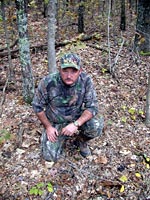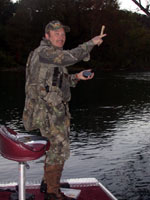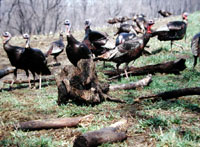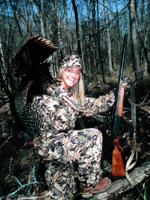
|
Features
|
|
|
|
Books
|
|
|
|
Fun & Games
|
|
|
|
Contact Us
|
|
|
John's Journal... Entry 168, Day 1
HOW TO HUNT FALL AND WINTER TURKEYS
How To Set Up on Fall Gobblers
 EDITOR'S
NOTE: The birds of fall and the winter are both
the easiest and the hardest to take, depending on the lengths of their
beards and spurs. The longbeards of the fall are the most-difficult turkeys
to bag at any time of the year. But the jakes, the bird less than a year
old, are easy to take. The hunter's strategy for taking the turkeys of
fall and winter is completely different from the techniques he'll use
in the spring. Sex is no longer important to the gobblers. The birds already
have passed through their mating cycles, and the hens have made their
nests, laid their eggs and reared their young. Fall calling and hunting
tactics are based primarily on the social order of turkeys more than on
the sex drive of the birds.
EDITOR'S
NOTE: The birds of fall and the winter are both
the easiest and the hardest to take, depending on the lengths of their
beards and spurs. The longbeards of the fall are the most-difficult turkeys
to bag at any time of the year. But the jakes, the bird less than a year
old, are easy to take. The hunter's strategy for taking the turkeys of
fall and winter is completely different from the techniques he'll use
in the spring. Sex is no longer important to the gobblers. The birds already
have passed through their mating cycles, and the hens have made their
nests, laid their eggs and reared their young. Fall calling and hunting
tactics are based primarily on the social order of turkeys more than on
the sex drive of the birds.
 "When
there is very little food in the woods, turkeys are usually more social,"
Alex Rutledge explains. "They call back and forth to each other more and
concentrate on the available food. For this reason, you'll often see longbeards
traveling with a hen and young turkeys to find food. Or, the longbeard
will come to the same food source for several consecutive days. So, if
you find him and can pinpoint the food he's eating, you can take him.
But even then if you scatter a flock that has longbeards in it, often
the long-bearded gobbler will take much longer to come to your calling
than the hens and young turkeys will. And if the area where you're hunting
has a high population of predators like foxes, bobcats and coyotes, the
older gobblers may not come back. Often it will be the next day before
you can go to the scatter spot and try and call in the longbeard. If you
scatter a flock with longbeards just before fly-up time in the evening,
you may be able to go to that spot and call the longbeard in the next
morning."
"When
there is very little food in the woods, turkeys are usually more social,"
Alex Rutledge explains. "They call back and forth to each other more and
concentrate on the available food. For this reason, you'll often see longbeards
traveling with a hen and young turkeys to find food. Or, the longbeard
will come to the same food source for several consecutive days. So, if
you find him and can pinpoint the food he's eating, you can take him.
But even then if you scatter a flock that has longbeards in it, often
the long-bearded gobbler will take much longer to come to your calling
than the hens and young turkeys will. And if the area where you're hunting
has a high population of predators like foxes, bobcats and coyotes, the
older gobblers may not come back. Often it will be the next day before
you can go to the scatter spot and try and call in the longbeard. If you
scatter a flock with longbeards just before fly-up time in the evening,
you may be able to go to that spot and call the longbeard in the next
morning."
 Since
the fall woods are open, and a turkey's eyesight is so keen, if you set
up in clean woods where the gobbler wants to walk, the chances of his
seeing you before he gets close enough for you to take a shot are very
good. But a terrain break can be beneficial to the fall turkey hunter.
A slightly rolling hill, a mountaintop, a small ridge or any type of hump
in the ground you can put between you and the turkey will increase your
odds of bagging that bird. That hump or hill will act as your blind. Then
when the turkey walks into view, you can see him. If he's within gun range,
you'll have an opportunity to bag him. However, if you're forced to take
a stand in an open area where a tom can watch from 100 to 200 yards as
he comes in, your chances for success are reduced greatly. But never set
up in a thicket or any kind of thick cover. Turkeys in the fall, like
turkeys in the spring, will avoid thickets. If you must set up in the
open, sit still, and pray the turkey doesn't see you before he gets close
enough for you to take a shot. Or, he may run or fly off.
Since
the fall woods are open, and a turkey's eyesight is so keen, if you set
up in clean woods where the gobbler wants to walk, the chances of his
seeing you before he gets close enough for you to take a shot are very
good. But a terrain break can be beneficial to the fall turkey hunter.
A slightly rolling hill, a mountaintop, a small ridge or any type of hump
in the ground you can put between you and the turkey will increase your
odds of bagging that bird. That hump or hill will act as your blind. Then
when the turkey walks into view, you can see him. If he's within gun range,
you'll have an opportunity to bag him. However, if you're forced to take
a stand in an open area where a tom can watch from 100 to 200 yards as
he comes in, your chances for success are reduced greatly. But never set
up in a thicket or any kind of thick cover. Turkeys in the fall, like
turkeys in the spring, will avoid thickets. If you must set up in the
open, sit still, and pray the turkey doesn't see you before he gets close
enough for you to take a shot. Or, he may run or fly off.
 One
strategy some turkey hunters have used successfully to bag fall and winter
gobblers is to hunt from tree stands. Deer hunters know turkeys will walk
under their stands and never look up to them. This tactic is especially
effective if you know where turkeys are feeding every day. However, turkey
hunting in the fall may mean covering a vast expanse of ground. Often
when you locate a flock of turkeys, you'll not have time to put up a tree
stand. But hunting from tree stands can be effective if you scatter a
flock of longbeards and plan to sit in one spot for some time.
One
strategy some turkey hunters have used successfully to bag fall and winter
gobblers is to hunt from tree stands. Deer hunters know turkeys will walk
under their stands and never look up to them. This tactic is especially
effective if you know where turkeys are feeding every day. However, turkey
hunting in the fall may mean covering a vast expanse of ground. Often
when you locate a flock of turkeys, you'll not have time to put up a tree
stand. But hunting from tree stands can be effective if you scatter a
flock of longbeards and plan to sit in one spot for some time.
TOMORROW: HOW TO HUNT THE YOUNG BIRDS OF FALL
Check back each day this week for more HOW TO HUNT FALL AND WINTER TURKEYS ...
Day 1 - How To Set Up on
Fall Gobblers
Day 2 - How to Hunt the Young Birds of Fall
Day 3 - How to Take Young Gobblers
Day 4 - How to Hunt Longbeards in the Fall
Day 5 - How to Hunt the Lone Wolves of Fall